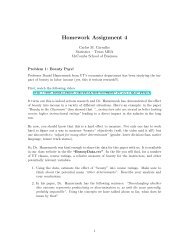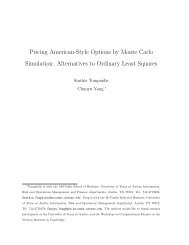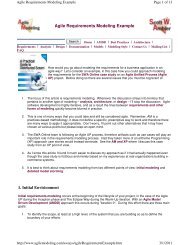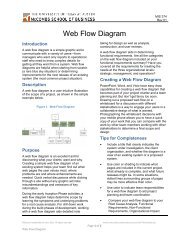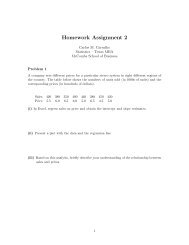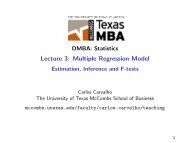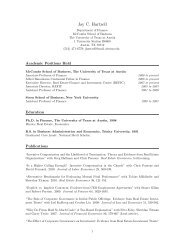Homework Assignment 2
Homework Assignment 2
Homework Assignment 2
You also want an ePaper? Increase the reach of your titles
YUMPU automatically turns print PDFs into web optimized ePapers that Google loves.
Problem 4: Match the PlotsBelow (Figure 1) are 4 different scatter plots of an outcome variable y versus predictor xfollowed by 4 four regression output summaries labeled A, B, C and D. Match the outputswith the plots.Figure 2: Scatter Plots4
Regression A:Coefficients:Estimate Std. Error(Intercept) 7.03747 0.12302(Slope) 2.18658 0.07801---Residual standard error: 1.226R-Squared: 0.8891Regression B:Coefficients:Estimate Std. Error(Intercept) 1.1491 0.1013(Slope) 1.4896 0.0583Residual standard error: 1.012R-Squared: 0.8695Regression C:Coefficients:Estimate Std. Error(Intercept) 1.2486 0.2053(Slope) 1.5659 0.1119Residual standard error: 2.052R-Squared: 0.6666Regression D:Coefficients:Estimate Std. Error(Intercept) 9.0225 0.0904(Slope) 2.0718 0.0270---Residual standard error: 0.902R-Squared: 0.98355
Problem 5: The SLR ModelSuppose we are modeling house price as depending on house size. Price is measured inthousands of dollars and size is measured in thousands of square feet.Suppose our model is:P = 20 + 50 s + ɛ, ɛ ∼ N(0, 15 2 ).(a) Given you know that a house has size s = 1.6, give a 95% predictive interval for theprice of the house.(b) Given you know that a house has size s = 2.2, give a 95% predictive interval for theprice.(c) In our model the slope is 50. What are the units of this number?(d) What are the units of the intercept 20?(e) What are the units of the the error standard deviation 15?(f) Suppose we change the units of price to dollars and size to square feetWhat would the values and units of the intercept, slope, and error standard deviation?(g) If we plug s = 1.6 into our model equation, P is a constant plus the normal randomvariables ɛ. Given s = 1.6, what is the distribution of P ?6
Problem 6: The Shock Absorber DataThe data comes from a company which supplies a major automobile manufacturer withshock absorbers. An important characteristic is the “force transferred through the shockabsorber when the shank is forced out of the cylinder”. If you don’t know what that reallymeans, don’t worry, neither do I.What we do need to understand is that the manufacturer only considers the shock to be anacceptable part if the force measurement is between 485 and 585.The shock manufacturer and the auto manufacturer are arguing over the following issue.Before the shock is finally shipped, it is filled with gas. After it is filled with gas, itbecomes very difficult to measure the force characteristic we are interested in. The shockmanufacturers would like to make the measurement before the shock is filled with gas. Theauto maker is concerned that there may be a difference in the force before and after theshock is filled with gas and so would like to make the measurement after it is filled.The shock maker claims that there is little difference between the before and after measurementso that the before measurement can be used.To investigate this we have the before (column 1, reboundb) and the after (column 2,rebounda) measurements on 35 shocks. The data for this problem is in shock.csv availablein the class website.(a) Plot the before measurement vs. the after measurement. Does this look like the kindof data we can use the simple linear regression model to think about? Why does itmake sense to choose the after measurement as “Y” and the before measurement as“X”?(b) What are 95% confidence intervals for both the slope and the intercept?(c) Test the null hypothesis H o : β 0 = 0.(d) From the shock maker’s point of view, what hypotheses would be of interest to test forthe slope and intercept. That is, what would the shock maker like the true interceptand slope to be?Test whether the intercept is equal to the value proposed by the shock maker.Test whether the slope is equal to the value proposed by the shock maker.(f) Suppose the before measurement is 550.What is the plug-in predictive interval given x-before=550.What does this interval suggest about the acceptability of the shock absorber?7
Problem 7Let Y and X denote the labor force participation rate of women in 1972 and 1968, respectively,in each of 19 cities in the US. The regression output for this data set in shown in theTable below:Variable Coefficient s.e. t-test p-valueIntercept 0.203311 0.0976 2.08 0.0526X 0.656040 0.1961 3.35 0.0036n = 19 R 2 = 0.397 s = 0.0566 d.f. = 17It was also found that SSR = 0.0358 and SSE = 0.0544.satisfies the usual regression assumptions.Suppose that the model(a) Compute the sample variance of Y and Corr(Y, X).(b) Suppose that the participation rate of women in 1968 in a given city is 45%. What isthe estimated participation rate of women in 1972 for the same city?(c) Construct the 95% confidence interval for the slope of the true regression line β 1(d) Test the hypothesis β 1 = 1 (with 95% probability).(e) If Y and X were reversed in the above regression, what would you expect R 2 to be?8
Problem 8The first regression was carried out in 1885 by Sir Francis Galton who wanted to see theeffect of parents’ height on the height of their children. We will reconsider this problemand take a look at a sample of heights for McCombs MBA students and their parents. Thedata is in file MBA-hgt.csv, and the variables are: SEX - One if female, else zero, SHGT -Student’s height in inches, MHGT - Mother’s height in inches, and FHGT - Father’s height ininches.(a) Create plots of student’s height vs each parent’s height. Briefly compare the plots.(b) What is the sample correlation between student’s height and mother’s height? Whatabout student’s height and father’s height? Which parent’s height do you think is abetter linear predictor for student’s height?(c) Find the sample mean and sample variance for each height variable. What are the leastsquares lines for student’s height regressed on mom’s height? What about student’sheight on dad’s height?(d) What is the variance decomposition for each of the regressions in (c) (i.e., what are theSST, SSE, and SSR). What is R 2 for each regression?(d) What are the residuals for your height(s) from the two prediction rules in (c)?9



